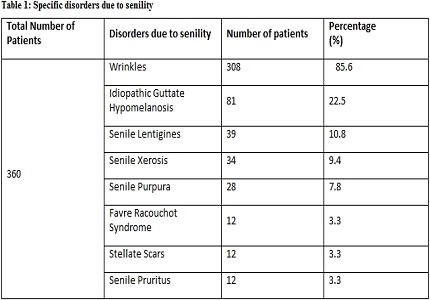A cross sectional observational study to evaluate various cutaneous manifestations in geriatric age group
Abstract
Introduction: With an improvement in medical services and with increased life expectancy, in both developed and developing nations, the geriatric population is increasing and with this their medical needs including their cutaneous problems are also gaining more attention. This study highlights the various dermatoses prevalent in the geriatric population. Early detection of few of the dermatoses not only helps in their early treatment but also prevents further progression. Skin being the mirror of the internal body system often gives definitive clues for diagnosing several systemic ailments which are quite common in this age group. On the other hand skin is also at the receiving end and many systemic illnesses and medications modify the dermatological presentation in the elderly population.
Methods: The geriatric patients (aged 60 years and above), attending Dermatology Out-patient Department in a tertiary hospital over a period of one year were included in this study. About 360 patients were included in this study.
Results: Itching was the commonest presenting complaint and wrinkles were the commonest dermatological finding. Disorders of hair and nails was also were very common. A total of 7 patients out of the study group had malignant skin cancers and they were managed and followed up after the end of the study period to note any recurrence.
Conclusion: The 60 and older patient population is a rapidly growing dermatology clientele with unique skin, hair, and nail issues. This study highlights the various dermatoses peculiar to the geriatric population and aims at sensitizing the fraternity to the specific needs of this special age group.
Downloads
References
2. Masoro EJ. Ageing: Current Concepts in Ageing. Edited by Masoro EJ, Oxford, England, Oxford University Press, 1995, p. 3.
3. Durai PC, Thappa DM, Kumari R, Malathi M. Aging in elderly: chronological versus photoaging. Indian J Dermatol. 2012 Sep;57(5):343-52. doi: 10.4103/0019-5154.100473.
4. Cerimele D, Celleno L, Serri F. Physiological changes in ageing skin. Br J Dermatol. 1990 Apr;122 Suppl 35:13-20. [PubMed]
5. Farage MA, Miller KW, Berardesca E, Maibach HI. Clinical implications of aging skin: cutaneous disorders in the elderly. Am J Clin Dermatol. 2009;10(2):73-86. doi: 10.2165/00128071-200910020-00001. [PubMed]
6. Roberts WE. Generational dermatology: model of prevention and multi-decade approach to the evolving aging patient. J Drugs Dermatol. 2013;12(12):1396-1397. [PubMed]
7. Rubegni P, Poggiali S, Nami N, Rubegni M, Fimiani M. Skin diseases in geriatric patients: our experience from a public skin outpatient clinic in Siena. G Ital Dermatol Venereol. 2012 Dec;147(6):631-6. [PubMed]
8. Lewis DA, Travers JB, Spandau DF. A new paradigm for the role of aging in the development of skin cancer. J Invest Dermatol. 2009 Mar;129(3):787-91. doi: 10.1038/jid.2008.293. Epub 2008 Sep 25. [PubMed]
9. S. W. Chan. Prevalence of skin problems in elderly homes residents in Hong Kong. Hong Kong Journal of Dermatology and Venereology, vol. 14, no. 2, pp. 66–70, 2006. [PubMed]
10. H. Cvitanović, E. Knežević, I. Kuljanac, and E. Jančić. Skin disease in a geriatric patients group in outpatient dermatologic clinic Karlovac, Croatia. Collegium Antropologicum, vol. 34, no. 2, pp. 247–251, 2010.
11. Beauregard S, Gilchrest BA. A survey of skin problems and skin care regimens in the elderly. Arch Dermatol. 1987;123:1638-43.



 OAI - Open Archives Initiative
OAI - Open Archives Initiative


